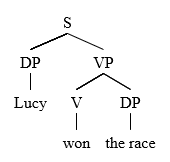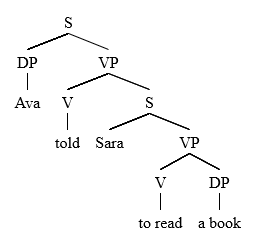Earley Parsing in CFG
After the ID/LP Grammar has been converted to the equivalent form within a CFG, the algorithm will analyze the string. Let  stand for start and
stand for start and  stand for the elements of the string and it also represents Syntactic Categories. The algorithm then analyzes the string and identifies the following:
stand for the elements of the string and it also represents Syntactic Categories. The algorithm then analyzes the string and identifies the following:
- The original position of the dot; it usually begins with the left-most element of the string.
- The current position of the dot; this predicts the following element.
- The production of the completed string. [9]
(1) 
(2)  (
( is being predicted)
is being predicted)
(3) 
The parsed strings are then used together to form a Parse List [10] for example:
 [10]
[10]
which the list will help determine whether the completed production element ( ) is accepted within the main string. It does this by looking whether the produced individual strings are found in the Parse List. If one or all of the individual strings are not found within the Parse List, then the overall string will fail. If one or all of the individual strings are found in the Parse List, then the overall string will be accepted. [10]
) is accepted within the main string. It does this by looking whether the produced individual strings are found in the Parse List. If one or all of the individual strings are not found within the Parse List, then the overall string will fail. If one or all of the individual strings are found in the Parse List, then the overall string will be accepted. [10]
Earley Parsing in UCFG
The UCFG is the appropriate equivalent to convert the ID/LP Grammar into in order to use the Earley Parser. [9] This algorithm read strings similarly to how it parses CFG, however, in this case the order of elements is not enforced; resulting in lack of LP rule enforcement. This allows some elements to be repeated within the parsed strings and the UCFG accepts empty multi-sets along with filled multi-sets within its strings. [9] For example:
- The origin position of the dot; it is between the empty set and the filled set.
- The current position of the dot which predicts the following set; the element that the dot passed will move into the empty set.
- The production of the completed string. In this case, the position of the two sets in the origin position will swap; the filled set is on the left edge and the empty set is on the right edge. [9]
(1) 
(2)  (
( are being predicted)
are being predicted)
(3) 
When parsing a string that contains a number of unordered elements, the Earley Parser treats it as a Permutation, Y!, and generates each string individually instead of using one string to represent the repeated parsed strings. [9] Whenever the dot moves over one element, the algorithm begins to generate parsed strings of the elements on the right edge in random positions until there are no more elements in the right edge set. Let X0 represent the original string and X1 as the first parsed string; for example:


string X1 will produce, 3! = 6, different parsed strings of the right edge set:
(1)  (4)
(4) 
(2)  (5)
(5) 
(3)  (6)
(6) 
The Earley Parser applies each string to the individual rules of a grammar [9] and this results in very large sets.The large sets is partly resulted in the conversion of ID/LP Grammar into an equivalent grammar, however, parsing the overall ID/LP Grammar is difficult to begin with. [9]





















































































